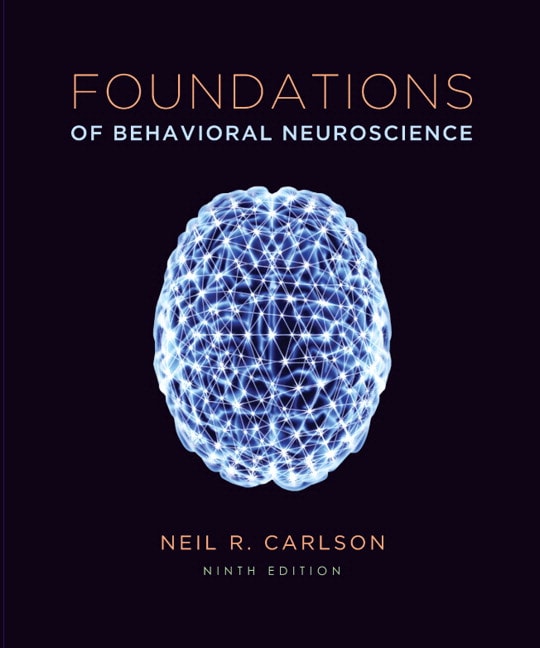
30.00$
Table of Contents
In this Section:
1. Brief Table of Contents
2. Full Table of Contents
1. Brief Table of Contents
Chapter 1: Origins of Behavioral Neuroscience
Chapter 2: Structure and Functions of Cells of the Nervous System
Chapter 3: Structure of the Nervous System
Chapter 4: Psychopharmacology
Chapter 5: Methods and Strategies of Research
Chapter 6: Vision
Chapter 7: Audition, the Body Senses, and the Chemical Senses
Chapter 8: Sleep and Biological Rhythms
Chapter 9: Reproductive Behavior
Chapter 10: Emotion
Chapter 11: Ingestive Behavior
Chapter 12: Learning and Memory
Chapter 13: Human Communication
Chapter 14: Neurological Disorders
Chapter 15: Schizophrenia, Affective Disorders, and Anxiety Disorders
Chapter 16: Autistic, Attention-Deficit, Stress,nd Substance Abuse Disorders
2. Full Table of Contents
Chapter 1: Origins of Behavioral Neuroscience
Understanding Human Consciousness: A Physiological Approach
The Nature of Behavioral Neuroscience
Natural Selection and Evolution
Ethical Issues in Research with Animals
Careers in Neuroscience
Strategies for Learning
Chapter 2: Structure and Functions of Cells of the Nervous System
Cells of the Nervous System
Communication Within a Neuron
Communication Between Neurons
Chapter 3: Structure of the Nervous System
Basic Features of the Nervous System
The Central Nervous System
The Peripheral Nervous System
Chapter 4: Psychopharmacology
Principles of Psychopharmacology
Sites of Drug Action
Neurotransmitters and Neuromodulators
Chapter 5: Methods and Strategies of Research
Experimental Ablation
Recording and Stimulating Neural Activity
Neurochemical Methods
Genetic Methods
Chapter 6: Vision
The Stimulus
Anatomy of the Visual System
Coding of Visual Information in the Retina
Analysis of Visual Information: Role of the Striate Cortex
Analysis of Visual Information: Role of the Visual Association Cortex
Chapter 7: Audition, the Body Senses, and the Chemical Senses
Audition
Vestibular System
Somatosenses
Gustation
Olfaction
Chapter 8: Sleep and Biological Rhythms
A Physiological and Behavioral Description of Sleep
Disorders of Sleep
Why Do We Sleep?
Physiological Mechanisms of Sleep and Waking
Biological Clocks
Chapter 9: Reproductive Behavior
Sexual Development
Hormonal Control of Sexual Behavior
Neural Control of Sexual Behavior
Parental Behavior
Chapter 10: Emotion
Emotions as Response Patterns
Communication of Emotions
Feelings of Emotions
Chapter 11: Ingestive Behavior
Physiological Regulatory Mechanisms
Drinking
Eating: Some Facts About Metabolism
What Starts a Meal?
What Stops a Meal?
Brain Mechanisms
Obesity
Anorexia Nervosa/Bulimia Nervosa
Chapter 12: Learning and Memory
The Nature of Learning
Synaptic Plasticity: Long-Term Potentiation and Long-Term Depression
Perceptual Learning
Classical Conditioning
Instrumental Conditioning
Relational Learning
Chapter 13: Human Communication
Speech Production and Comprehension: Brain Mechanisms
Disorders of Reading and Writing
Chapter 14: Neurological Disorders
Tumors
Seizure Disorders
Cerebrovascular Accidents
Traumatic Brain Injury
Disorders of Development
Degenerative Disorders
Disorders Caused by Infectious Diseases
Chapter 15: Schizophrenia, Affective Disorders, and Anxiety Disorders
Schizophrenia
Major Affective Disorders
Anxiety Disorders
Chapter 16: Autistic, Attention-Deficit, Stress,nd Substance Abuse Disorders
Autistic Disorder
Attention-Deficit/Hyperactivity Disorder
Stress Disorders
Substance Abuse Disorders
***THIS IS NOT THE ACTUAL BOOK. YOU ARE BUYING the Test Bank in e-version of the following book***
Foundations of Behavioral Neuroscience, 9th Edition PDF Manual Solutions , PDF Foundations of Behavioral Neuroscience, 9th Edition , Fast Download Foundations of Behavioral Neuroscience, 9th Edition , Neil R. Carlson, University of Massachusetts, Amherst,Category : Higher Education

0 commentaires:
Enregistrer un commentaire